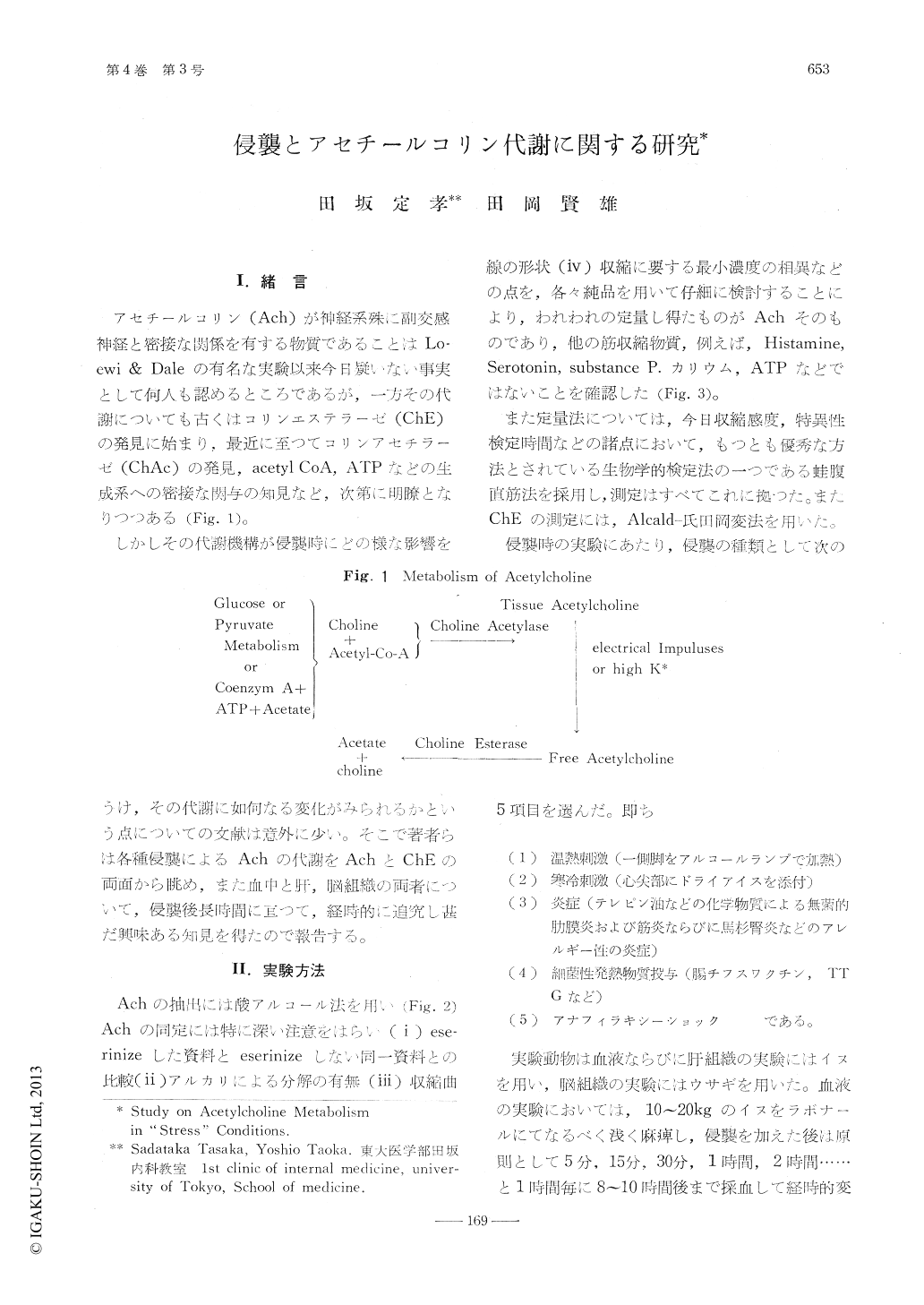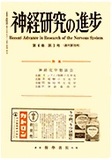Japanese
English
- 有料閲覧
- Abstract 文献概要
- 1ページ目 Look Inside
I.緒言
アセチールコリン(Ach)が神経系殊に副交感神経と密接な関係を有する物質であることはLoewi & Daleの有名な実験以来今日疑いない事実として何人も認めるところであるが,一方その代謝についても古くはコリンエステラーゼ(ChE)の発見に始まり,最近に至つてコリンアセチラーゼ(ChAc)の発見,acetyl CoA,ATPなどの生成系への密接な関与の知見など,次第に明瞭となりつつある(Fig. 1)。
しかしその代謝機構が侵襲時にどの様な影響をうけ,その代謝に如何なる変化がみられるかという点についての文献は意外に少い。そこで著者らは各種侵襲によるAchの代謝をAchとChEの両面から眺め,また血中と肝,脳組織の両者について,侵襲後長時間に亘つて,経時的に追究し甚だ興味ある知見を得たので報告する。
Our experiments aim at the study on acetylcholine metabolism in the organism to clarify therole of acetylcholine and its release mechanism inthe "stress" conditions.
Dogs and rabbits were used as experimentalamimals. Various stress conditions were producedas follows; ① burns in leg ② precordial application of cold (Dry ice) ③ Intrapleural and intramuscular injection of chemical agents. (Terpentine oil) ④ Intravenous injection of bacterial pyrogens. (i) typhoid vaccin (0.005-0.01m/kg) (ii) lipopolysaccaride-protein complex from pseudomonas fluorescens (5~10γ/kg) ⑤ Anaphylatic shock
Acetylcholine contents and cholinesterase activitiesin blood, liver and brain tissues were measuredwith time course of the stress conditions.
The measurement of acetylcholine was made byFrog's restus abdominis method. Tissue specimens were frozen and homogenized. Acetylcholinein blood or tissue was extracted with acidulatedalcohol. Concerned with the identification ofacetylcholine in biological specimens, it was confirmed that the minimal concentration causingcontraction and the contracting shapes for acetylcholine and quite differed from those of othermuscle contracting substances, such as histamine, serotonin, substance P, ATP and potassium.
Serum cholinesterase activities was estimated by Alcald-Taoka's colorimetric method. The originalmethod was improved in several points for theenzymatic activity in tissues by the authors.
Blood acetylcholine increased and reached thehighest concentration 4-8 hours after osccillatorywave were found to be drawn in serum colinesterase activity
Acetylcholine content in tissue (liver) decreaseimmediately in "stress" conditions, and thenterned to increase gradually beyond the originalvalue before the stress.
This change is due to the variation of bothbound and free acetylcholine.
The variation of the bound form showed thesame tendency as that of the free and seemed toproceed the latter.
On the other hand, the flucturation of cholinesterase activity in liver was not parallel with thatof acetylcholine content in the same tissue, butwith the change of serum cholinesterase activity.
Brain acetylcholine decrease immediately afterinjection of bacterial Pyrogens and then increasedgradually to reach the maximum, when bodytemperature of the animals rose highest. Andagain, it return rapidly to the normal value withlowering of elevated body temperature.
These changes of acetylcholine contents in braintissues, fluctuated only within limitted range andwere more marked in brain stem and the upperpart of spinal cord than in cerebellum and cerebrum.
Their cholinesterase activities were found to beparallel with the variation of acetylcholine contents in the same brain tissues.
These obtained data suggest that the mode ofvariation of acetylcholine and cholinesterase inblood and tissues might he non-specific to stressors.

Copyright © 1960, Igaku-Shoin Ltd. All rights reserved.


